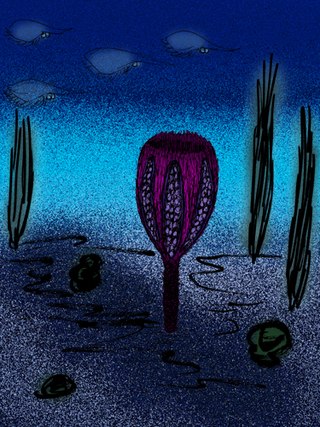Related Research Articles

Ctenorhabdotus capulus is an extinct species of ctenophore, known from the Burgess shale in British Columbia, Canada. It is approximately 515 to 505 million years old and was equipped with 24 comb rows, three times as many as known from modern ctenophores. 5 specimens of Ctenorhabdotus are known from the Greater Phyllopod bed, where they comprise < 0.1% of the community.
Dalyia is a pterobranch known from the middle Cambrian Burgess shale. It was previously interpreted as a red alga. It has smooth or faintly lineated stems, which branch into up to four equal branches at branching points. 37 specimens of Dalyia are known from the Greater Phyllopod bed, where they comprise 0.07% of the community.
Dictyophycus is a putative red alga of the middle Cambrian Burgess shale. While alive, it formed leaf-like lobes about 25mm across. The fossils do not preserve the leaf-like membrane, so only the sturdier "skeleton" is known; these are usually broken and detached from their holdfast. 308 specimens of Dictyophycus are known from the Greater Phyllopod bed, where they comprise 0.59% of the community.
Liangshanella is a genus of Cambrian bradoriid known from the Chengjiang biota and Burgess Shale. 6263 specimens of Liangshanella are known from the Greater Phyllopod bed, where they comprise 11.9% of the community.

Morania is a genus of cyanobacterium preserved as carbonaceous films in the Middle Cambrian Burgess Shale. it is present throughout the shale; 2580 specimens of Morania are known from the Greater Phyllopod bed, where they comprise 4.90% of the community. It is filamentous, forms sheets, and resembles the modern cyanobacterium Nostoc. It would have had a role in binding the sediment, and would have been a food source for such organisms as Odontogriphus and Wiwaxia.
The Phyllopod bed, designated by USNM locality number 35k, is the most famous fossil-bearing member of the Burgess Shale fossil Lagerstätte. It was quarried by Charles Walcott from 1911–1917, and was the source of 95% of the fossils he collected during this time; tens of thousands of soft-bodied fossils representing over 150 genera have been recovered from the Phyllopod bed alone.
Chaunograptus is a genus of putative graptolite known from the Middle Cambrian Burgess Shale. 11 specimens of Chaunograptus are known from the Greater Phyllopod bed, where they comprise 0.02% of the community.
Bosworthia is a genus of branching photosynthetic alga known from the Middle Cambrian Burgess Shale. 20 specimens of Bosworthia are known from the Greater Phyllopod bed, where they comprise 0.04% of the community. One of its two original species has since been reassigned to Walcottophycus.
Acrothyra gregaria is a species of gregarious brachiopod known from the Middle Cambrian Burgess Shale. 253 specimens of Acrothyra are known from the Greater Phyllopod bed, where they comprise 0.5% of the community.
Ehmaniella is a genus of trilobite known from the Middle Cambrian Burgess Shale. 392 specimens of Ehmaniella are known from the Greater Phyllopod bed, where they comprise 0.74% of the community.

Falospongia is a genus of sponge made up of radiating fronds, known from the Middle Cambrian Burgess Shale. Its name is derived from the Latin fala ("scaffold") and spongia ("sponge"), referring to the open framework of the skeleton. It superficially resembles Haplistion but is monaxial. 5 specimens of Falospongia are known from the Greater Phyllopod bed, where they comprise under 0.1% of the community.
Fieldospongia is a genus of sea sponge known from the Middle Cambrian Burgess Shale. Just five specimens of Fieldospongia are known from the Greater Phyllopod bed, where they comprise less than 0.1% of the community.
Mackenzia is an elongated bag-like animal known from the Middle Cambrian Burgess Shale. It attached directly to hard surfaces, such as brachiopod shells. 14 specimens of Mackenzia are known from the Greater Phyllopod bed, where they comprise <0.1% of the community. Mackenzia was originally described by Charles Walcott in 1911 as a holothurian echinoderm. Later, Mackenzia is thought to be a cnidarian and appears most similar to modern sea anemones.

Micromitra is a genus of brachiopods known from the Middle Cambrian Burgess Shale. 160 specimens of Micromitra are known from the Greater Phyllopod bed, where they comprise 0.3% of the community.

Petaloptyon danei is a goblet-shaped hexactinellid sponge known from rare fragments from the Middle Cambrian Burgess Shale. A few specimens of Petaloptyon are known from the Greater Phyllopod bed, where they comprise under 0.01% of the community.

Oryctocephalus is a genus of trilobite known from the Middle Cambrian Burgess Shale. 24 specimens of Oryctocephalus are known from the Greater Phyllopod bed, where they comprise 0.42% of the community. This small- to medium-sized trilobite's major characteristics are prominent eye ridges, pleural spines, long genal spines, spines on the pygidium, and notably four furrows connecting pairs of pits on its glabella. Juvenile specimens have been found with only 5 or 6 thoracic segments and about one eighth of adult size, as well as about 2 mm wide.
Protospongia is a genus of Porifera known from the Middle Cambrian Burgess Shale. 102 specimens of Protospongia are known from the Greater Phyllopod bed, where they comprise 0.19% of the community.
Wapkia is an extinct genus of sea sponge with radial sclerites, known from the Middle Cambrian Burgess Shale. It was first described in 1920 by Charles Doolittle Walcott. 32 specimens of Wapkia are known from the Greater Phyllopod bed, where they comprise 0.06% of the community.
Wahpia is a genus of alga known from the Middle Cambrian Burgess Shale. 33 specimens of Wahpia are known from the Greater Phyllopod bed, where they comprise 0.06% of the community.

Diagoniella is a genus of sponge known from the Middle Cambrian Burgess Shale. 128 specimens of Diagoniella are known from the Greater Phyllopod bed, where they comprise 0.24% of the community.
References
- ↑ Caron, Jean-Bernard; Jackson, Donald A. (October 2006). "Taphonomy of the Greater Phyllopod Bed community, Burgess Shale". PALAIOS. 21 (5): 451–65. Bibcode:2006Palai..21..451C. doi:10.2110/palo.2003.P05-070R. JSTOR 20173022. S2CID 53646959.